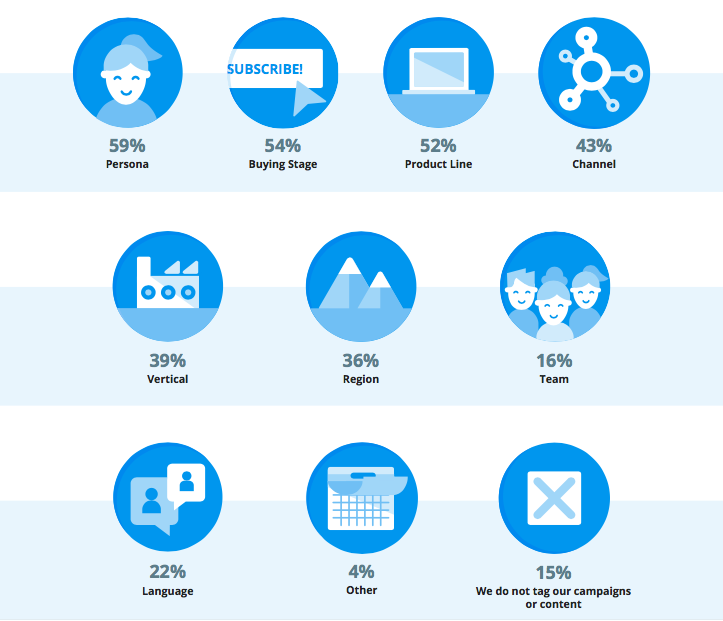B2B marketers are producing more content than ever and have been for a while. The significance of this trend is that you probably have a diverse content inventory from which to pull relevant assets to help push prospects down the funnel. But if your audience—or even internal teams—can’t find that perfect piece of content at the right time, it doesn’t really matter how much content you have.
It should come as no surprise that the key to ensuring the findability of your content comes from properly tagging it. An effective search feature is based on proper titling, metadata, and keywords. You will not be able to fully implement your content operation if you don’t strategically build a taxonomy that connects to your overall business priorities.
Where Do We Currently Stand?
SiriusDecisions estimates that 65% of content in B2B marketing gets unused, and of the main usage problems, 25% are attributable to findability issues.
Fortunately, in our B2B Content Strategy and Operations Benchmark, we found that 85% of marketers were tagging at least some strategic contexts. See the results below:

The essential concept behind a taxonomy is “the science of naming, describing, and classifying” objects and organisms so that we can see patterns in the myriad of information. But when it comes to digital marketing, building a taxonomy is more than simply organizing all your assets.
At Kapost, we use the following definition:
“A strategic taxonomy is a holistic look at the metadata fields that are used to tag content assets across the multiple software tools in your MarTech stack.”
The system of tagging and titling that you use to organize your content is mainly implemented for the sake of findability. Use keywords and categories to help both internal and external audiences find what they need right when they want it.
But, more importantly, your taxonomy should reflect your overall content strategy and goals. The tagging of your content acts as the skeleton within your digital presence, and if it doesn’t reflect your overall organizational goals, all the most beautifully written content will never truly deliver on the investment it required.
Five Key Best Practices for a Mature Taxonomy
So how can we improve the process of content tags? Here are five ways to ensure that you build a mature taxonomy to backup your stellar content operation.
1. Always Begin—and Continue—with Why
As with any strategy, the trick to making it stick is setting a foundation of why the effort should be directed toward implementing it. This is a theme that will be carried through all the rest of the steps.
The unfortunate reality is that tagging content is tedious. When you create a stack of blog post ideas, you don’t want to be bogged down by clicking all those little boxes—that is, unless you feel truly invested in why it’s important to do so. The approach of change management with implementing a new tagging system involves bringing everyone on the same page regarding the changes. Find ways to explain why tagging is necessary within a variety of contexts.
You have to think of your content production as a library. You may have the most diverse and in-depth categories of resources available, but if researchers come into the building and have no idea where to look, they’re just going to leave. All your effort into procuring and producing content is meaningless if there’s no one to read it.
Similarly, if you have a prospect browsing your site without properly tagged content or if your sales team can’t find an asset to send to a potential customer, it doesn’t matter how much effort you put into the copy and design of that piece of content. No one is going to read it. The entire content operation becomes obsolete.
Those are the stakes you need to understand yourself and communicate to everyone who produces and publishes content. And it may need to be re-emphasized periodically. Make sure that everyone understands why this tedious task is so important to maintain for your entire content operation.
2. Align with Business Priorities
But as we said above, creating a robust tagging system is more than findability. A mature taxonomy system also allows you to understand your own gaps and strengths within your content strategy.
Let’s dig into this a little more. Aligning your content production with organizational priorities is key to implementing a successful content operation. Properly and thoroughly tagging your content allows you to gather metrics about all the areas you are reaching—and which ones you’re not. With such data in hand, your operation will seamlessly address gaps in your content strategy as needed.
“As content strategists, we have to think about taxonomy from the perspective of what terms and structure will help the content perform best and support the organization’s business goals. We also have to consider the longevity and flexibility of the taxonomy.” – Natalya Minkovsky, editor for the Content Marketing Institute’s Chief Content Officer magazine
With consistently tagged content, you can also track which kinds of content perform better (including which types of content contribute the most to closed deals), and thus, you will pour more of your resources efficiently into content that pays dividends.
3. Bring Teams Onboard
Building off of the first two steps, make sure to bring teams and departments into the fold with why you’re building a tagging system and how you’ll tie it to business priorities. Alignment and buy-in are vital aspects whenever you implement new strategies, and this is no less true for a taxonomy system implementation. A robust taxonomy takes a village to build and execute successfully.
To align your teams regarding the taxonomy of your content, begin by analyzing your existing content and metadata. Gather input and opinions from across your organization as much as possible. See how internal audiences like sales and customer success currently search for content. Take note of any pain points they experience. Involve stakeholders early in the process to streamline implementation later. Have at least one round of gathering feedback after creating a preliminary system so that you can address minor adjustments as necessary.
Also, once you have a system in place (see the next section) conduct an cross-team training to make sure everyone is on the same page about how to tag and again, why they should be tagging all the content they produce.
4. Build a Taxonomy System Step by Step
The first step in building a healthy taxonomy system is to designate someone as the project leader. This is a person who fully understands and believes in the importance of tagging content—and if you’ve gotten this far in the article, this project leader is probably you.
The project leader will be responsible for ensuring the completion of implementing a taxonomy and establishing that everyone understands why tagging is important. If this is out of the scope of your current team’s bandwidth, consider hiring a consultant. Those with experience in library science are especially effective in this job because libraries are built on the ability to find content quickly.
To start putting together a taxonomy system, first classify your existing content. Chances are, you do indeed have a content repository already, but the various assets are scattered to the wind. If that’s the case, an audit is in order. While the word, “audit” can be frightening, it doesn’t have to be. And it should nevertheless be tackled if you want your content to have an impact.
Put all of your content in a single repository. Use spreadsheets if you must, be we highly recommend a content operations platform (COP) like Kapost that acts as a single source of truth to house and organized the entire content creation, distribution, and analytic processes.
Use your existing content to get a feel for the kind of organization you want moving forward. Classify your content based on related terminology, keywords, buyer personas, channels, teams, regions, and buying stages. Choose the categories that matter most to your organization’s priorities. Maybe language is important if you sell your product internationally; maybe categorize based on the vertical placement of your customers is more fundamental.
There’s no one right way to tag your content; the appropriate amount will be based on your business and your industry. Generally, in B2B marketing, buyer persona, channel, and journey stage will allow you to survive on the bare minimum.
Keep in mind that there are different levels of taxonomy:
- Titles: Include key phrases in the titles of content assets to ensure findability through your search feature. For internal-facing titles, include the content type, exact title, edition, and even channel. For external content like blog posts, limit your taxonomy to SEO optimization
- Categories: These should be broad topics that are intimately connected to your organization’s business priorities. Categories should be thoroughly planned, well-organized, and kept to a minimum number to provide ease of navigation
- Tags: With this level, you can focus more on trends and fluid topics. You can also include far more variety of tags that you could for categories. Keep your common tags flexible, adding and culling as needed
- Keywords: For keyword tagging, follow general SEO best practices. This is a larger topic that’s discussed in more detail in this post
Create documentation of your new system and put it somewhere everyone can find it. Define what your best practices for titling are, what all of your categories encompass, what kind of tags are appropriate in each channel, and how to implement your SEO strategy. Again, include your reasoning behind all these choices. Documenting your taxonomy is a critical element of an overall documented content strategy.
5. Schedule Regular Check-Ins
The needs of your target audiences and your organization’s priorities will evolve with the times—your taxonomy should reflect that. Create a regular schedule of updating your tagging systems to keep up with the changes. Updates can come annually for major aspects like categories or tags that relate to overall strategic goals; for more time-sensitive tags like keywords or aspects related to product development, consider a more frequent schedule. Keep in mind that you shouldn’t change the overall structure too often.
Tied to your taxonomy check-in are regular audits of your content. If you’ve been implementing a strategic tagging system, audits become much easier. Create expiration dates for content so that you can ensure that your audiences, both internal and external, are only finding relevant, up-to-date content. Decide how long you want certain assets to be available: infographics may only have a three-year lifespan, while templates are more evergreen.
Even if you have a content type that you feel needs little in the way of regular updates, you may still want to refresh it periodically. If it’s really a valuable asset, a makeover now and then can’t hurt. Give that old eBook a fresh look and some relevant stats so that your audience can gain fresh insights into how to use the information effectively.
Final Thoughts on Strategically Tagging Content
Building and maintaining a mature taxonomy may not seem like the most glamorous part of marketing, but it truly is a critical element to fully implementing your content operation. Communicating that importance will contribute to the consistency of putting the system into practice. Taking the time to carefully define and document your taxonomy will aid this consistency as well. And as we know, consistency is key to a positive customer experience.

